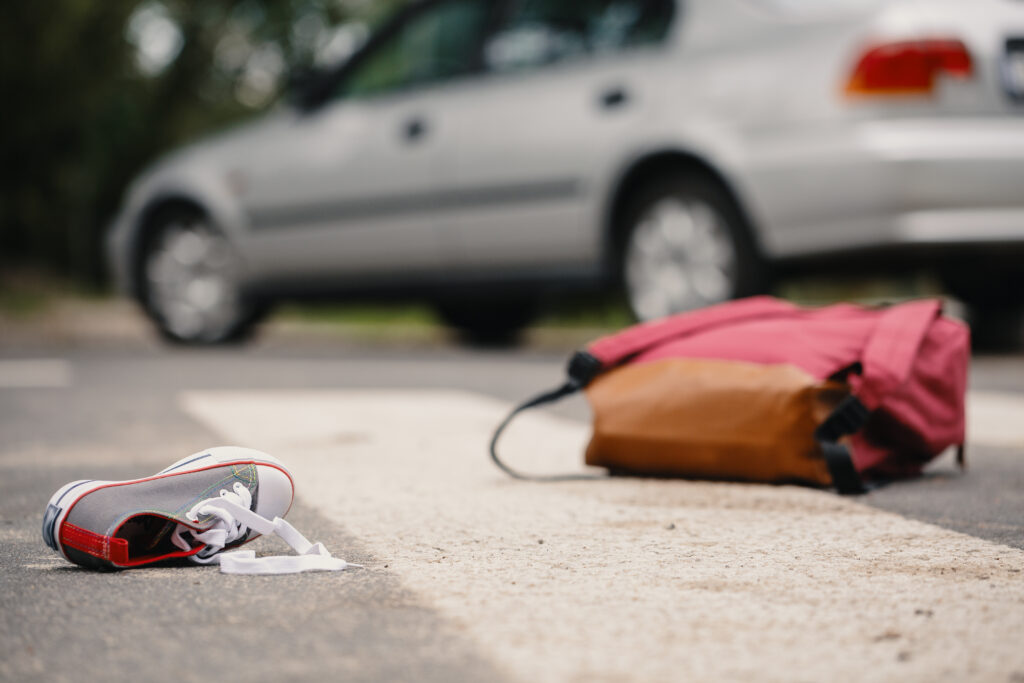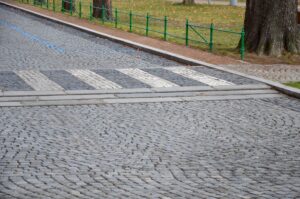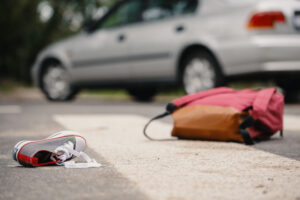Injuries on Raised Crosswalks
cartwrightlaw - March 6, 2023 -

Pedestrian accidents happen in crosswalks more than you might imagine. If you get hit by a car or suffer other injuries due to dangerous crosswalks, speak with a pedestrian accident attorney today.
There are four basic types of crosswalks: those that are controlled or uncontrolled and those that are marked or unmarked. Controlled crosswalks are those that have a traffic signal or a stop or yield sign, any of which will require a driver to stop for a pedestrian crossing. “Stop-controlled” crossings use a stop sign that requires vehicles to stop before they enter the crosswalk. A “signalized” crossing usually occurs at an intersection but may sometimes occur at heavily used midblock locations. These crossings have a traffic signal controlling both pedestrian and motorist traffic.
An uncontrolled crossing has no signs or traffic signals. They may be marked on the pavement so that pedestrians know whether to cross and warn drivers to look out for pedestrians. These occur at both intersections and midblock locations. Even if there are no signs, signals, or painted lines, any intersection where a pedestrian can cross is legally a crosswalk and subject to the local laws allowing pedestrians to cross. They do not, however, provide the rights of way and other crosswalk legal protections. Unmarked crossings are generally the most common crossings outside of downtown urban areas.

Enhanced lighting at intersections makes it easier for drivers to see pedestrians in darker areas. This lighting is especially important to draw attention to midblock crossing locations. Stop bars, which are wide white strips painted at the intersection, also help to increase driver awareness of the need to stop at an intersection. Other aids to dealing with crosswalks include warning signs that a crossing is ahead and “stop here” signs indicating where the driver should stop. In-street warning signs get installed in the lane to make the crosswalk more visible and increase driver compliance.
Pedestrian islands and bump-outs both serve to decrease the time the pedestrian is actually in the roadway. Islands appear in the middle of the street and allow a safe stopping point for pedestrians and vehicles to stop when a signal change catches them mid-crossing. Bump-outs shorten the actual crossing distance by stretching out the curb into traffic. These often increase driver discomfort, however, and can slow traffic.
Raised crosswalks are among the more recent developments in crosswalk technology and are becoming more common as their effectiveness becomes apparent.
Raised Crosswalks
Raised crosswalks are ramped crossings that act, in effect, as speed bumps spanning the street, marked out with paint and special paving. These crosswalks intentionally slow traffic and allow pedestrians to cross the street at the same grade as the sidewalk. They also improve accessibility by allowing pedestrians to cross intersections without dealing with curb ramps. They also make pedestrians more visible to drivers because they are elevated above the roadbed.
Raised crosswalks are used on local and collector streets, campus settings, shopping areas, and pick-up and drop-off zones at airports, schools, transit centers, and medical facilities. They are also valuable for parking lots to slow traffic and allow pedestrians to access vehicles more safely.
The raised crosswalks are essentially ramped speed bumps stretching across the entire intersection where the pedestrians will cross. They are often placed at frequently used midblock crossing locations and are usually only as wide as a standard crosswalk. The crosswalks are usually about 10 feet wide and flush with the height of the adjacent sidewalk. Their design allows the front and rear wheels of a passenger vehicle to be on the crosswalk at the same time. The crosswalks also have warnings and ramps for pedestrians with impaired vision.
Purpose
Local and collector roads with high-speed limits and heavy traffic pose a significant challenge for pedestrians attempting to cross the roadway. Motorists have slower reaction times at higher speeds, and additional measures may be needed to improve motorist speed and compliance with pedestrian rights-of-way. Raised pedestrian crossings and intersections reduce vehicle speeds, reduce the need for curb ramps (though truncated domes should still appear), and enhance the pedestrian crossing environment.
Pedestrian Risks
According to the Department of Motor Vehicles, pedestrian deaths account for approximately one of every five traffic collision fatalities in California. As a result, the Federal Highway Administration issued a memorandum outlining acceptable methods of safety features to help increase pedestrian safety, specifically at uncontrolled marked crosswalks. Raised crosswalks considerably reduce these risks by slowing traffic like a speed bump.
Risks of Raised Crosswalks
Experience shows that raised crosswalks are not without their own risks. Drivers crash into the crosswalks because they can be hard to see, particularly at dusk, dawn, or night. When not adequately signed or lighted, the crosswalks can present a significant risk to drivers who encounter them at regular speed, risking significant damage to the undercarriage of their vehicle.

There are construction and placement issues with raised crosswalks. For example, they do not work well on bus routes and those used as primary routes for emergency vehicles. These types of vehicles can experience damage by hitting what are essentially speed bumps at high speed or in a manner that their vehicles can’t handle well.
They can also interfere with drainage on streets and create problems for snow plows. In general, they do not work well on curvy roads or steep grades.
Public Response
Raised crosswalks often appear at intersections, particularly at the entrance of the minor street. Since these installations can cause discomfort and noise (especially from larger vehicles crossing the ramp), getting public buy-in may not be easy. As noted above, the public may find raised crosswalks inappropriate for bus transit or primary emergency vehicle routes.
Costs
Raised crosswalks are not cheap. Depending on the size of the road crossed and its drainage conditions, the crossing can cost between $25,000 and $100,000. Other estimates say that depending the whether their construction features asphalt, concrete, or pavers, the materials costs will be between $7,000 and $31,000.
Safety of Raised Crosswalks
Essentially, raised crosswalks offer far more safety than they do risk. They usually reduce vehicle speeds and make crossing easier and more secure for pedestrians.
If you are in a crosswalk accident, the pedestrian lawyers at The Cartwright Law Firm can help. Contact us today for a free consultation.
Pedestrian accidents happen in crosswalks more than you might imagine. If you get hit by a car or suffer other injuries due to dangerous crosswalks, speak with a pedestrian accident attorney today.
There are four basic types of crosswalks: those that are controlled or uncontrolled and those that are marked or unmarked. Controlled crosswalks are those that have a traffic signal or a stop or yield sign, any of which will require a driver to stop for a pedestrian crossing. “Stop-controlled” crossings use a stop sign that requires vehicles to stop before they enter the crosswalk. A “signalized” crossing usually occurs at an intersection but may sometimes occur at heavily used midblock locations. These crossings have a traffic signal controlling both pedestrian and motorist traffic.
An uncontrolled crossing has no signs or traffic signals. They may be marked on the pavement so that pedestrians know whether to cross and warn drivers to look out for pedestrians. These occur at both intersections and midblock locations. Even if there are no signs, signals, or painted lines, any intersection where a pedestrian can cross is legally a crosswalk and subject to the local laws allowing pedestrians to cross. They do not, however, provide the rights of way and other crosswalk legal protections. Unmarked crossings are generally the most common crossings outside of downtown urban areas.

Enhanced lighting at intersections makes it easier for drivers to see pedestrians in darker areas. This lighting is especially important to draw attention to midblock crossing locations. Stop bars, which are wide white strips painted at the intersection, also help to increase driver awareness of the need to stop at an intersection. Other aids to dealing with crosswalks include warning signs that a crossing is ahead and “stop here” signs indicating where the driver should stop. In-street warning signs get installed in the lane to make the crosswalk more visible and increase driver compliance.
Pedestrian islands and bump-outs both serve to decrease the time the pedestrian is actually in the roadway. Islands appear in the middle of the street and allow a safe stopping point for pedestrians and vehicles to stop when a signal change catches them mid-crossing. Bump-outs shorten the actual crossing distance by stretching out the curb into traffic. These often increase driver discomfort, however, and can slow traffic.
Raised crosswalks are among the more recent developments in crosswalk technology and are becoming more common as their effectiveness becomes apparent.
Raised Crosswalks
Raised crosswalks are ramped crossings that act, in effect, as speed bumps spanning the street, marked out with paint and special paving. These crosswalks intentionally slow traffic and allow pedestrians to cross the street at the same grade as the sidewalk. They also improve accessibility by allowing pedestrians to cross intersections without dealing with curb ramps. They also make pedestrians more visible to drivers because they are elevated above the roadbed.
Raised crosswalks are used on local and collector streets, campus settings, shopping areas, and pick-up and drop-off zones at airports, schools, transit centers, and medical facilities. They are also valuable for parking lots to slow traffic and allow pedestrians to access vehicles more safely.
The raised crosswalks are essentially ramped speed bumps stretching across the entire intersection where the pedestrians will cross. They are often placed at frequently used midblock crossing locations and are usually only as wide as a standard crosswalk. The crosswalks are usually about 10 feet wide and flush with the height of the adjacent sidewalk. Their design allows the front and rear wheels of a passenger vehicle to be on the crosswalk at the same time. The crosswalks also have warnings and ramps for pedestrians with impaired vision.
Purpose
Local and collector roads with high-speed limits and heavy traffic pose a significant challenge for pedestrians attempting to cross the roadway. Motorists have slower reaction times at higher speeds, and additional measures may be needed to improve motorist speed and compliance with pedestrian rights-of-way. Raised pedestrian crossings and intersections reduce vehicle speeds, reduce the need for curb ramps (though truncated domes should still appear), and enhance the pedestrian crossing environment.
Pedestrian Risks
According to the Department of Motor Vehicles, pedestrian deaths account for approximately one of every five traffic collision fatalities in California. As a result, the Federal Highway Administration issued a memorandum outlining acceptable methods of safety features to help increase pedestrian safety, specifically at uncontrolled marked crosswalks. Raised crosswalks considerably reduce these risks by slowing traffic like a speed bump.
Risks of Raised Crosswalks
Experience shows that raised crosswalks are not without their own risks. Drivers crash into the crosswalks because they can be hard to see, particularly at dusk, dawn, or night. When not adequately signed or lighted, the crosswalks can present a significant risk to drivers who encounter them at regular speed, risking significant damage to the undercarriage of their vehicle.

There are construction and placement issues with raised crosswalks. For example, they do not work well on bus routes and those used as primary routes for emergency vehicles. These types of vehicles can experience damage by hitting what are essentially speed bumps at high speed or in a manner that their vehicles can’t handle well.
They can also interfere with drainage on streets and create problems for snow plows. In general, they do not work well on curvy roads or steep grades.
Public Response
Raised crosswalks often appear at intersections, particularly at the entrance of the minor street. Since these installations can cause discomfort and noise (especially from larger vehicles crossing the ramp), getting public buy-in may not be easy. As noted above, the public may find raised crosswalks inappropriate for bus transit or primary emergency vehicle routes.
Costs
Raised crosswalks are not cheap. Depending on the size of the road crossed and its drainage conditions, the crossing can cost between $25,000 and $100,000. Other estimates say that depending the whether their construction features asphalt, concrete, or pavers, the materials costs will be between $7,000 and $31,000.
Safety of Raised Crosswalks
Essentially, raised crosswalks offer far more safety than they do risk. They usually reduce vehicle speeds and make crossing easier and more secure for pedestrians.
If you are in a crosswalk accident, the pedestrian lawyers at The Cartwright Law Firm can help. Contact us today for a free consultation.
“Our successful case results are a reflection of the values and virtues we believe in and uphold at Cartwright Law Firm. Nothing stops us from pursuing justice on behalf of those who need it.
Robert E. Cartwright Jr.
Founder and Managing Partner

